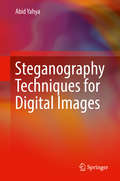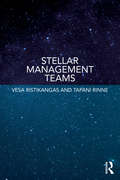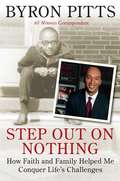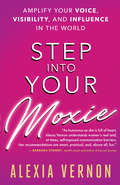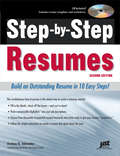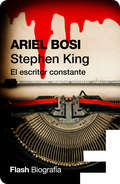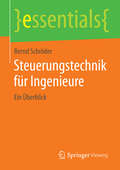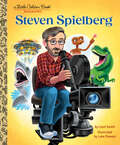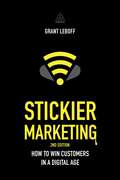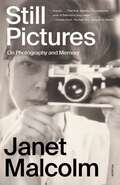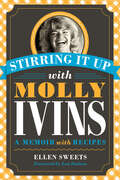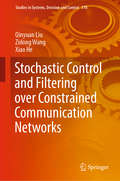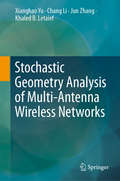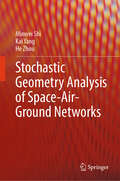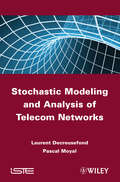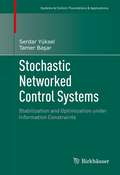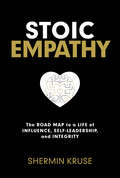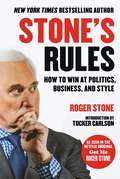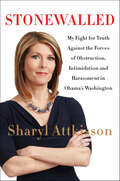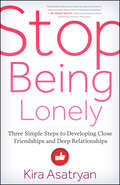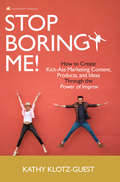- Table View
- List View
Steganography Techniques for Digital Images
by Abid YahyaThis book covers newly developed and novel Steganography techniques and algorithms. The book outlines techniques to provide security to a variety of applications using Steganography, with the goal of both hindering an adversary from decoding a hidden message, and also preventing an adversary from suspecting the existence of covert communications. The book looks into applying these newly designed and improved algorithms to provide a new and efficient Steganographic system, called Characteristic Region-Based Image Steganography (CR-BIS). The algorithms combine both the robustness of the Speeded-Up Robust Features technique (SURF) and Discrete Wavelet Transform (DWT) to achieve characteristic region Steganography synchronization. The book also touches on how to avoid hiding data in the whole image by dynamically selecting characteristic regions for the process of embedding. Applies and discusses innovative techniques for hiding text in a digital image file or even using it as a key to the encryption;Provides a variety of methods to achieve characteristic region Steganography synchronization;Shows how Steganography improves upon cryptography by using obscurity features.
Steganography in Digital Media
by Jessica FridrichSteganography, the art of hiding of information in apparently innocuous objects or images, is a field with a rich heritage, and an area of rapid current development. This clear, self-contained guide shows you how to understand the building blocks of covert communication in digital media files and how to apply the techniques in practice, including those of steganalysis, the detection of steganography. Assuming only a basic knowledge in calculus and statistics, the book blends the various strands of steganography, including information theory, coding, signal estimation and detection, and statistical signal processing. Experiments on real media files demonstrate the performance of the techniques in real life, and most techniques are supplied with pseudo-code, making it easy to implement the algorithms. The book is ideal for students taking courses on steganography and information hiding, and is also a useful reference for engineers and practitioners working in media security and information assurance.
Stellar Management Teams
by Vesa Ristikangas Tapani RinneManagement teams at all levels, and individual team members in particular, are often disengaged and disconnected from the management function itself. Statements such as, "we lack common goals or they are unclear", "I have no influence", "I am not listened to nor taken into account", and "I do not feel valued – actually, nobody does", are commonplace. The authors argue this is because we have been entrenched in an era of guru leadership but that it must come to an end if our management teams are to rise to the top. An individual is not capable of controlling the complicated system of an organization, with its countless variables, especially in conjunction with the rapid change in both the economy and market forces, which are unpredictable and uncontrollable. No matter how talented the individual, no one person is in a position to manage this complex system alone – not even a guru leader. The authors contend that what is needed now are resilient trendsetters who will bring about a new era of top-performing teams that together form a "collective guru", which they refer to as a Stellar Management Team. In this book, the reader undertakes a metaphorical journey to the stars, which symbolizes top-level interaction and collaboration. The journey is the development from an ordinary management team into a Stellar Management Team, which elevates its operation up to a new level of performance and success.
Step Out on Nothing: How Faith and Family Helped Me Conquer Life's Challenges
by Byron PittsIt was August 25, 2006, my first on-camera studio open for the CBS News broadcast 60 Minutes. Executive Producer Jeff Fager poked his head in the dressing room. "Good luck, Brotha! You've come a long way to get here. You've earned it." If only he knew. My mind flashed back to elementary school, when a therapist had informed my mother, "I'm sorry, Mrs. Pitts, your son cannot read. " In Step Out on Nothing, Byron Pitts chronicles his astonishing story of overcoming a childhood filled with obstacles to achieve enormous success in life. Throughout Byron's difficult youth - his parents separated when he was twelve and his mother worked two jobs to make ends meet - he suffered from a debilitating stutter. But Byron was keeping an even more embarrassing secret: He was also functionally illiterate. For a kid from inner-city Baltimore, it was a recipe for failure. Pitts turned struggle into strength and overcame both of his impediments. Along the way, a few key people "stepped out on nothing" to make a difference for him - from his mother, who worked tirelessly to raise her kids right and delivered ample amounts of tough love, to his college roommate, who helped Byron practice his vocabulary and speech. Pitts even learns from those who didn't believe in him, like the college professor who labeled him a failure and told him to drop out of college. Through it all, he persevered, following his steadfast passion. After fifteen years in local television, he landed a job as a correspondent for CBS News in 1998, and went on to become an Emmy Award - winning journalist and a contributing correspondent for 60 Minutes. Not bad for a kid who couldn't read. From a challenged youth to a reporting career that has covered 9/11 and Iraq, Pitts's triumphant and uplifting story will resonate with anyone who has felt like giving up in the face of seemingly insurmountable hardships.
Step Out on Nothing: How Faith and Family Helped Me Conquer Life's Challenges
by Byron PittsIt was August 25, 2006, my first on-camera studio open for the CBS News broadcast 60 Minutes. Executive Producer Jeff Fager poked his head in the dressing room." Good luck, Brotha! You've come a long way to get here. You've earned it."…If only he knew. My mind flashed back to elementary school, when a therapist had informed my mother, "I'm sorry, Mrs. Pitts, your son cannot read."In Step Out on Nothing, Byron Pitts chronicles his astonishing story of overcoming a childhood filled with obstacles to achieve enormous success in life. Throughout Byron's difficult youth—his parents separated when he was twelve and his mother worked two jobs to make ends meet—he suffered from a debilitating stutter. But Byron was keeping an even more embarrassing secret: He was also functionally illiterate. For a kid from inner-city Baltimore, it was a recipe for failure.Pitts turned struggle into strength and overcame both of his impediments. Along the way, a few key people "stepped out on nothing" to make a difference for him—from his mother, who worked tirelessly to raise her kids right and delivered ample amounts of tough love, to his college roommate, who helped Byron practice his vocabulary and speech. Pitts even learns from those who didn't believe in him, like the college professor who labeled him a failure and told him to drop out of college. Through it all, he persevered, following his steadfast passion. After fifteen years in local television, he landed a job as a correspondent for CBS News in 1998, and went on to become an Emmy Award–winning journalist and a contributing correspondent for 60 Minutes. Not bad for a kid who couldn't read.From a challenged youth to a reporting career that has covered 9/11 and Iraq, Pitts's triumphant and uplifting story will resonate with anyone who has felt like giving up in the face of seemingly insurmountable hardships.
Step into Your Moxie: Amplify Your Voice, Visibility, and Influence in the World
by Alexia VernonPREPARE TO TRANSFORM YOUR VOICE AND BE HEARD Step into Your Moxie is a soul-stirring call to action to speak up for yourself and the ideas and issues that matter most to you. Dubbed a “Moxie Maven” by President Obama’s White House Office of Public Engagement for her potent approach to women’s empowerment, Alexia Vernon has helped thousands of women (and men) slay diminishing self-talk and cultivate confidence. She has created a timely, refreshingly playful guide for women to communicate with candor, clarity, compassion, and ease every time they open their mouths to speak — in their careers, communities, and homes. Step into Your Moxie is the book women want by their side as they have that daring conversation, give an important presentation, run for office, or simply tell the people closest to them to step back from the boundaries they’ve trespassed.
Step-by-Step Resumes
by Evelyn U SalvadorAn extensive collection of thousands of powerful resume keywords to help readers' resumes stand out in electronic databases.
Stephen King: El escritor constante
by Ariel BosiUna interesante introducción a la vida y obra del maestro del horror. De la mano de Ariel Bosi, uno de los mayores expertos en la vida y obra del Rey de Reyes, conocerás los inicios como escritor de Stephen King, sus muchos fracasos, sus penurias económicas y sus principales logros como autor; los cimientos que le convirtieron en el más importante escritor vivo de literatura de terror. «Hora soy escritor. Muchísimos críticos creen que lo que escribo es una mierda [...] Mi historia se parece tantísimo a un cuento de hadas que resulta absurda.»Stephen King, El cuerpo
Steuerungstechnik für Ingenieure: Ein Überblick (essentials)
by Bernd SchröderFür selbstarbeitende und automatisierte (Produktions-) Prozesse werden Steuerungstechniken genutzt. Die hierzu eingesetzten Elemente arbeiten mechanisch, pneumatisch, hydraulisch, elektrisch oder elektronisch. Ausführende Organe sind unter anderem Ventile, Pumpen, Motore, Schalter, Sensoren und Relais. Die hierfür gängigen Symbole werden vorgestellt und können in Schemata eingesetzt werden. Gelegentlich ist die Erstellung sequenzieller Schaltungen hilfreich. Für eine hohe Flexibilität bietet sich die speicherprogrammierbare Steuerung (SPS) an.
Steven Spielberg: A Little Golden Book Biography (Little Golden Book)
by Geof SmithDream big with a Little Golden Book biography about Hollywood's most famous director Steven Spielberg. It's the perfect introduction to nonfiction for young readers—as well as fans of all ages!This Little Golden Book about Steven Spielberg—the Academy Award-winning director of iconic films such as Jaws, E.T. The Extra-Terrestrial, Jurassic Park, Schindler's List, and the Indiana Jones original film trilogy—is an inspiring read-aloud for young children and fans of any age.Look for more Little Golden Book biographies:Betty WhiteDwanye JohnsonOprah WinfreyCarol BurnettJulie Andrews
Stickier Marketing
by Grant LeboffIn Sticky Marketing Grant Leboff argued that the old marketing system of shouting messages at people was finished, replaced by providing value around your product or service: brands needed to become sticky. This new edition of Sticky Marketing, Stickier Marketing, remains a complete guide to producing effective marketing communications in a world of consumers empowered by new digital technology who do not want to be shouted at but engaged with. It shows readers how providing return on engagement, rather than return on investment, and a customer engagement point, rather than a unique selling point, is what will make the difference in today's cluttered marketing place. Updated throughout, this new edition also includes brand new chapters on content marketing, discovery and mobile marketing.
Stickier Marketing: How to Win Customers in a Digital Age
by Grant LeboffIn Sticky Marketing Grant Leboff argued that the old marketing system of shouting messages at people was finished, replaced by providing value around your product or service: brands needed to become sticky. This new edition of Sticky Marketing, Stickier Marketing, remains a complete guide to producing effective marketing communications in a world of consumers empowered by new digital technology who do not want to be shouted at but engaged with. It shows readers how providing return on engagement, rather than return on investment, and a customer engagement point, rather than a unique selling point, is what will make the difference in today's cluttered marketing place. Updated throughout, this new edition also includes brand new chapters on content marketing, discovery and mobile marketing.
Still Pictures: On Photography and Memory
by Janet Malcolm“Superb . . . [The] final, splendid, most personal work of [Janet Malcolm’s] long career.” —Charles Finch, The New York Times Book ReviewFor decades, Janet Malcolm’s books and dispatches for The New Yorker and The New York Review of Books poked and prodded at reportorial and biographical convention, gesturing toward the artifice that underpins both public and private selves. In Still Pictures, she turns her gimlet eye on her own life—a task demanding a writer just as peerlessly skillful as she was widely known to be.Still Pictures, then, is not the story of a life but an event on its own terms, an encounter with identity and family photographs as poignant and original as anything since Roland Barthes’s Camera Lucida. Malcolm looks beyond the content of the image and the easy seductions of self-recognition, constructing a memoir from memories that pose questions of their own. Still Pictures begins with the image of a morose young girl on a train, leaving Prague for New York at the age of five in 1939. From her fitful early loves, to evenings at the old Metropolitan Opera House, to her fascination with what it might mean to be a “bad girl,” Malcolm assembles a composite portrait of a New York childhood, one that never escapes the tug of Europe and the mysteries of fate and family. Later, Still Pictures delves into her marriage to Gardner Botsford, the world of William Shawn’s New Yorker, and the libel trial that led Malcolm to become a character in her own drama. Displaying the sharp wit and astute commentary that are Malcolmian trademarks, this brief volume develops into a memoir like few others in our literature.
Stirring It Up with Molly Ivins: A Memoir with Recipes
by Ellen SweetsYou probably knew Molly Ivins as an unabashed civil libertarian who used her rapier wit and good ole Texas horse sense to excoriate political figures she deemed unworthy of our trust and respect. But did you also know that Molly was one helluva cook? And we’re not just talking chili and chicken-fried steak, either. Molly Ivins honed her culinary skills on visits to France—often returning with perfected techniques for saumon en papillote or delectable clafouti aux cerises. Friends who had the privilege of sharing Molly’s table got not only a heaping helping of her insights into the political shenanigans of the day, but also a mouth-watering meal, prepared from scratch with the finest ingredients and assembled with the same meticulous attention to detail that Molly devoted to skewering a political recalcitrant. In Stirring It Up with Molly Ivins, her longtime friend, fellow reporter, and frequent sous-chef Ellen Sweets takes us into the kitchen with Molly and introduces us to the private woman behind the public figure. She serves up her own and others’ favorite stories about Ivins as she recalls the fabulous meals they shared, complete with recipes for thirty-five of Molly’s signature dishes. These stories reveal a woman who was even more fascinating and complex than the “professional Texan” she enjoyed playing in public. Friends who ate with Molly knew a cultured woman who was a fluent French speaker, voracious reader, rugged outdoors aficionado, music lover, loyal and loving friend, and surrogate mom to many of her friends’ children, as well as to her super-spoiled poodle. They also came to revere the courageous woman who refused to let cancer stop her from doing what she wanted, when she wanted. This is the Molly you’ll be delighted to meet in Stirring It Up with Molly Ivins.
Stochastic Control and Filtering over Constrained Communication Networks (Studies in Systems, Decision and Control #178)
by Zidong Wang Qinyuan Liu Xiao HeStochastic Control and Filtering over Constrained Communication Networks presents up-to-date research developments and novel methodologies on stochastic control and filtering for networked systems under constrained communication networks. It provides a framework of optimal controller/filter design, resilient filter design, stability and performance analysis for the systems considered, subject to various kinds of communication constraints, including signal-to-noise constraints, bandwidth constraints, and packet drops. Several techniques are employed to develop the controllers and filters desired, including:recursive Riccati equations;matrix decomposition;optimal estimation theory; andmathematical optimization methods.Readers will benefit from the book’s new concepts, models and methodologies that have practical significance in control engineering and signal processing. Stochastic Control and Filtering over Constrained Communication Networks is a practical research reference for engineers dealing with networked control and filtering problems. It is also of interest to academics and students working in control and communication networks.
Stochastic Geometry Analysis of Multi-Antenna Wireless Networks
by Jun Zhang Xianghao Yu Chang Li Khaled B. LetaiefThis book presents a unified framework for the tractable analysis of large-scale, multi-antenna wireless networks using stochastic geometry. This mathematical analysis is essential for assessing and understanding the performance of complicated multi-antenna networks, which are one of the foundations of 5G and beyond networks to meet the ever-increasing demands for network capacity. Describing the salient properties of the framework, which makes the analysis of multi-antenna networks comparable to that of their single-antenna counterparts, the book discusses effective design approaches that do not require complex system-level simulations. It also includes various application examples with different multi-antenna network models to illustrate the framework’s effectiveness.
Stochastic Geometry Analysis of Space-Air-Ground Networks
by Kai Yang Minwei Shi He ZhouThis book presents a comprehensive framework for the theoretical analysis of space-air-ground networks using stochastic geometry. This analytical approach is indispensable for evaluating the performance of large-scale space-air-ground networks, which serve as critical facilitators for the advancement of the sixth-generation wireless communication aimed at providing high-speed broadband coverage for remote areas. By incorporating the features of topology and channel model in different tiers, this book investigates the key performance metrics in terms of load balancing, coverage assessment, and mobility management. The developed mechanisms provide effective design insights for space-air-ground networks while obviating the need for complex system-level simulations.
Stochastic Modeling and Analysis of Telecom Networks
by Pascal Moyal Laurent DecreusefondThis book addresses the stochastic modeling of telecommunication networks, introducing the main mathematical tools for that purpose, such as Markov processes, real and spatial point processes and stochastic recursions, and presenting a wide list of results on stability, performances and comparison of systems. The authors propose a comprehensive mathematical construction of the foundations of stochastic network theory: Markov chains, continuous time Markov chains are extensively studied using an original martingale-based approach. A complete presentation of stochastic recursions from an ergodic theoretical perspective is also provided, as well as spatial point processes. Using these basic tools, stability criteria, performance measures and comparison principles are obtained for a wide class of models, from the canonical M/M/1 and G/G/1 queues to more sophisticated systems, including the current “hot topics” of spatial radio networking, OFDMA and real-time networks. Contents 1. Introduction. Part 1: Discrete-time Modeling 2. Stochastic Recursive Sequences. 3. Markov Chains. 4. Stationary Queues. 5. The M/GI/1 Queue. Part 2: Continuous-time Modeling 6. Poisson Process. 7. Markov Process. 8. Systems with Delay. 9. Loss Systems. Part 3: Spatial Modeling 10. Spatial Point Processes.
Stochastic Networked Control Systems
by Tamer Başar Serdar YükselNetworked control systems are increasingly ubiquitous today, with applications ranging from vehicle communication and adaptive power grids to space exploration and economics. The optimal design of such systems presents major challenges, requiring tools from various disciplines within applied mathematics such as decentralized control, stochastic control, information theory, and quantization. A thorough, self-contained book, Stochastic Networked Control Systems: Stabilization and Optimization under Information Constraints aims to connect these diverse disciplines with precision and rigor, while conveying design guidelines to controller architects. Unique in the literature, it lays a comprehensive theoretical foundation for the study of networked control systems, and introduces an array of concrete tools for work in the field. Salient features included: · Characterization, comparison and optimal design of information structures in static and dynamic teams. Operational, structural and topological properties of information structures in optimal decision making, with a systematic program for generating optimal encoding and control policies. The notion of signaling, and its utilization in stabilization and optimization of decentralized control systems. · Presentation of mathematical methods for stochastic stability of networked control systems using random-time, state-dependent drift conditions and martingale methods. · Characterization and study of information channels leading to various forms of stochastic stability such as stationarity, ergodicity, and quadratic stability; and connections with information and quantization theories. Analysis of various classes of centralized and decentralized control systems. · Jointly optimal design of encoding and control policies over various information channels and under general optimization criteria, including a detailed coverage of linear-quadratic-Gaussian models. · Decentralized agreement and dynamic optimization under information constraints. This monograph is geared toward a broad audience of academic and industrial researchers interested in control theory, information theory, optimization, economics, and applied mathematics. It could likewise serve as a supplemental graduate text. The reader is expected to have some familiarity with linear systems, stochastic processes, and Markov chains, but the necessary background can also be acquired in part through the four appendices included at the end. · Characterization, comparison and optimal design of information structures in static and dynamic teams. Operational, structural and topological properties of information structures in optimal decision making, with a systematic program for generating optimal encoding and control policies. The notion of signaling, and its utilization in stabilization and optimization of decentralized control systems. · Presentation of mathematical methods for stochastic stability of networked control systems using random-time, state-dependent drift conditions and martingale methods. · Characterization and study of information channels leading to various forms of stochastic stability such as stationarity, ergodicity, and quadratic stability; and connections with information and quantization theories. Analysis of various classes of centralized and decentralized control systems. · Jointly optimal design of encoding and control policies over various information channels and under general optimization criteria, including a detailed coverage of linear-quadratic-Gaussian models. · Decentralized agreement and dynamic optimization under information constraints. This monograph is geared toward a broad audience of academic and industrial researchers interested in control theory, information theory, optimization, economics, and applied mathematics. It could likewise serve as a supplemental graduate text. The reader is expected to have some familiarity with linear systems, stochastic processes, and Markov chai...
Stochastic Networks
by Frank Kelly Elena YudovinaIn the past decade the proliferation of local and global communication networks for computer and human communication, the development of parallel computers with large numbers of processors, and the design of flexible and robust manufacturing systems have spurred major advances in our understanding of queuing volume reviews recent progress. While research on queuing networks uses many of the traditional queuing theory insights, it is more concerned with how network components interact than with detailed models of how an individual queue behaves. In the last few years there have been some surprises, in particular with regard to the conditions for stability of multiclass queuing networks, which is covered in this book. It also covers the challenges reflected Brownian motion has set both as a mathematical object and as a modelling paradigm; the usefulness of ideas from the interacting particle system world; the application of large deviation theory; and the developing connections with optimization and dynamical systems theory.
Stoic Empathy: The Road Map to a Life of Influence, Self-Leadership, and Integrity
by Shermin KruseCorrect the power imbalances in your work and life with a science-backed practice that combines the rigor of Stoic philosophy with the relational impact of empathy.Stoicism combined with empathy may sound like a contradiction in terms. But when these seemingly opposing forces are harnessed together, they have the power to change your life.From surviving missile attacks and political oppression in Iran to leading high-stakes legal teams and negotiations in corporate America, Shermin Kruse's journey fuels her mission to merge empathy and stoicism as tools for navigating power, justice, and human connection in every facet of life. In this eye-opening book, she offers you this radical perspective shift—anchored in up-to-the-minute research—to help you navigate life's challenges with power and principles.We often think of empathy as an emotional stance: we feel what someone else is feeling. But Kruse outlines a form of empathy that&’s based in cognition, not emotion—a way for us to understand what the other person is thinking and feeling while keeping a distance from their feeling state—and shows us how we can strategically maneuver our level of engagement from &“emotional empathy&” to &“cognitive empathy&” in different circumstances. Then she utilizes Stoic philosophy and modern science to outline the how of emotional regulation and control. The bridge she builds between Stoicism and empathy gives us the knowledge and discipline we need to:Calmly assess the power dynamics of any situation Understand and manage our own emotions as well as the emotions of othersDefuse danger and turn conflict into connectionSkillfully steer a challenging conversation toward the result we wantWhether you're a leader striving to succeed in your role with integrity, an educator seeking to guide curious minds with compassion, a parent nurturing resilience in your children, or simply facing a personal or professional crossroads, Stoic Empathy is an essential toolkit for negotiating success in every area of your life.
Stone's Rules: How to Win at Politics, Business, and Style
by Tucker Carlson Roger StoneRules to live by from the master of political dark arts, as seen in the award-winning documentary Get Me Roger StoneAt long last, America’s most notorious political operative has released his operating manual!A freedom fighter to his admirers, a dirty trickster to his detractors, the flamboyant, outrageous, articulate, and extraordinarily well-dressed Roger Stone lays out Stone’s Rules—the maxims that have governed his legendary career as a campaign operative for four American presidents, from Richard Nixon and Ronald Reagan to Donald Trump.As a raconteur, pundit, prognosticator, and battle-scarred veteran of America’s political wars, Roger Stone shares his lessons on punking liberals and playing the media, gives an inside look at his push to legalize marijuana, details how much "linen" to show at the cuff of an impeccably-cut suit, lays out how and why LBJ orchestrated the murder of JFK, and reveals how to make the truly great marinara sauce that is the foundation of Stone’s legendary Sunday Gravy.Along the way, Stone dishes on the "cloak and dagger" nitty-gritty that has guided his own successes and occasional defeats, culminating in the election of the candidate he first pushed for the presidency in 1988, Donald J. Trump.First revealed in the Weekly Standard by Matt Labash and commemorated by CNN’s Jeffrey Toobin, the blunt, pointed, and real-world practical Stone’s Rules were immortalized in the Netflix smash hit documentary Get Me Roger Stone—part Machiavelli's The Prince, part Sun Tzu’s The Art of War, all brought together with a highly-entertaining blend of culinary and sartorial advice from the Jedi Master of political dark arts.From "Attack, attack, attack!" inspired by Winston Churchill, to "Three can keep a secret, if two are dead,” taken from the wall of mob boss Carlos Marcello’s headquarters, to Stone’s own “It is better to be infamous than to never have been famous at all,” Roger Stone shares with the world all that he’s learned from his decades of political jujitsu and life as a maven of high-style. From Stone’s Rules for campaign management to the how-to’s of an internet mobilization campaign to advice on custom tailoring to the ingredients for the perfect martini from Dick Nixon's (no-longer) secret recipe, Stone has fashioned the truest operating manual for anyone navigating the rough-and-tumble of business, finance, politics, social engagement, family affairs, and life itself.
Stonewalled: My Fight for Truth Against the Forces of Obstruction, Intimidation, and Harassment in Obama's Washington
by Sharyl AttkissonSeasoned CBS reporter Sharyl Attkisson reveals how she has been electronically surveilled while digging deep into the Obama Administration and its scandals, and offers an incisive critique of her industry and the shrinking role of investigative journalism in today’s media.Americans are at the mercy of powerful figures in business and government who are virtually unaccountable. The Obama Administration in particular has broken new ground in its monitoring of journalists, intimidation and harassment of opposition groups, and surveillance of private citizens.Sharyl Attkisson has been a journalist for more than thirty years. During that time she has exposed scandals and covered controversies under both Republican and Democratic administrations. She has also seen the opponents of transparency go to ever greater lengths to discourage and obstruct legitimate reporting.Attkisson herself has been subjected to “opposition research” efforts and spin campaigns. These tactics increased their intensity as she relentlessly pursued stories that the Obama Administration dismissed. Stonewalled is the story of how her news reports were met with a barrage of PR warfare tactics, including online criticism, as well as emails and phone calls up the network chain of command in an effort to intimidate and discourage the next story. In Stonewalled, Attkisson recounts her personal tale, setting it against the larger story of the decline of investigative journalism and unbiased truth telling in America today.
Stop Being Lonely: Three Simple Steps to Developing Close Friendships and Deep Relationships
by Kira AsatryanLoneliness Has an Antidote: The Feeling of Closeness Loneliness isn’t something that happens only when we are physically alone. It can also happen when we are with people. Online friends, followers, or “likers” don’t necessarily add up to much when you crave fulfilling interaction, and satisfying, long-term relationships are not a mystery to be left up to chance (or technology). The good news is that, according to relationship coach Kira Asatryan, loneliness has a reliable antidote: the feeling of closeness. We can and should cultivate closeness in our relationships using the steps outlined in this book: knowing, caring, and mastering closeness. Whether with romantic partners, friends, family members, or business colleagues, these techniques will help you establish true closeness with others. The simple and straightforward actions Asatryan presents in this wonderfully practical book will guide you toward better relationships and less loneliness in all social contexts.
Stop Boring Me!: How to Create Kick-Ass Marketing Content, Products and Ideas Through the Power of Improv
by Kathy Klotz-GuestComing up constantly with a steady stream of marketing content, stories, and ideas that inspire excitement, interest and banish boring can be challenging. Your content-weary audience is saying "Stop Boring Me!" You cannot connect meaningfully with your audience if you bore them. There's just too much content chasing too little mindshare today. And most business marketing stinks because it is transactional, superficial and not human. The good news: it doesn't have to be that way because everyone is creative. Your inner kid is smart because it knows how to play. What if you could create engaging marketing content and storytelling, and generate kick-ass, fun and relevant ideas for stories, articles, branding, social media campaigns, sales presentations, and even new products? Well there is a fun way to do exactly that: by applying key concepts from the world of improvisation. Don't worry - this is not about theatricality, so you don't have to perform. It is about playfulness, however, and unleashing your inner kid. Bringing key concepts from the improvisation stage to your marketing, sales, branding and products page - or business stage, if you like - can help you, your team, your company and your business generate ideas that kick boring to the curb. While this book will help you be more funny, it's focused on fun as a creative catalyst for content idea orgasms: when different things come together in a fresh, human and engaging way that makes you and your audience say "aww yeah!" The first half of the book centers on how to use key improv concepts to craft and tell better stories for sales, social media, articles, presentations, content, and other story-related contexts. The second half of the book is all about innovating massively creative marketing ideas for products, content, campaigns, customer service, sales processes, you name it. While this book was written primarily for marketing people who have to create content, tell stories, make presentations; anyone in the idea-generation business (and who isn't) can use the tips in this book. Whether you are in marketing, sales, HR, product or customer service, these exercises will help you innovate and unleash more creative awesome into your work. Here is to more idea orgasms for you and your audience.
